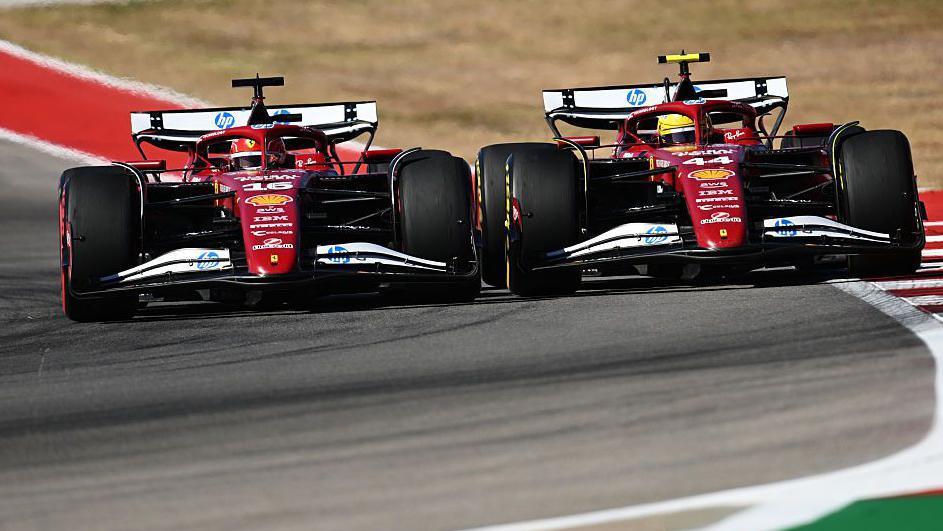Can McLaren continue to play fair and stop Verstappen? - F1 Q&A

- Published
Red Bull's Max Verstappen narrowed the gap in the drivers' championship by winning the sprint and main races at the United States Grand Prix.
Lando Norris finished second on Sunday to cut Oscar Piastri's championship lead to 14 points with five races remaining.
Four-time world champion Verstappen is now only 40 points behind Piastri going into this weekend's Mexico City Grand Prix.
BBC F1 correspondent Andrew Benson answers your latest questions.
Do McLaren have to face the truth of F1 now - that if you want to win, you can't always play fair? How do they take a cannier approach to prevent Max Verstappen swooping in and stealing the championship from under their nose? - Sam
McLaren are well aware of the challenge they face with Max Verstappen and Red Bull in the drivers' championship this year, but they see no reason to change their approach to running the team.
They will continue to give both drivers the best chance they can and operate the team on a basis of fairness and equanimity.
As team principal Andrea Stella put it in Austin: "This is the way we intend racing. This is the way in which we approach racing, and we want to remain fair, and we want to apply equality to both drivers."
Stella is a veteran of many title battles. He won the championship as engineer to Kimi Raikkonen in 2007 when the Ferrari driver made up 17 points under the old scoring system in two races to win the title, while McLaren imploded.
And he lost the title as engineer to Fernando Alonso in 2010, when Ferrari messed up their strategy at the final race of the season and allowed Sebastian Vettel and Red Bull to sneak the championship from under their noses.
Stella said after the race in Austin: "We look at the next five races as opportunities to increase the gap on Max. And when it comes to having to make a call as to a driver, this will only be led by mathematics.
"We lean on the experience. I can recall at least 2007, 2010, in which you go to the last race and it's actually the [driver in] third [place] that wins the championship. So we're not going to close the door unless this is closed by mathematics."
Why did McLaren stop upgrades on this year's car when there is no guarantee in 2026 they will have the fastest car? - John
Every team this year has had to face the conundrum of how long to focus on their 2025 car while also ensuring they are as prepared as they can be for the major regulation change coming for 2026.
In F1, it's usually the case that if a team gets it wrong at the start of a new rules cycle, it can take a long time to catch up. And if they get it right, that advantage can last for a while - look at Red Bull in 2022 and 2023, the last time the rules changed.
McLaren started this year with the best car, after putting a lot of innovation into their 2025 design.
They did continue to develop it for a while, but were finding diminishing returns. So when looking at the bang for buck they were getting on their 2025 car versus 2026, it became an easy decision to switch focus to next year.
Red Bull have caught up since introducing their new floor and front wing at the Italian Grand Prix, but the McLaren remains competitive - team principal Stella said he believed Lando Norris had the pace to compete for the win in Austin had he not ended up behind Charles Leclerc.
As Stella put it: "We just have to keep maximising the performance and keep executing good weekends. And from this point of view, if you think of a race like Baku, we didn't maximise the performance and we didn't execute a perfect race.
"So definitely we have a large opportunity, and the outcome of this season and the drivers' championship is in our hands. It's not in someone else's hands."

The Ferraris of Charles Leclerc (left) and Lewis Hamilton (right) briefly battled for third position during the United States Grand Prix, before the Monegasque pitted for fresh tyres
It seems to me that both Lewis Hamilton and Carlos Sainz have now proven themselves to be the equal of their team-mates in their first season at their teams. Do you think we downplay how difficult it is to switch teams? - Gareth
First of all, I'm not sure the question has an entirely accurate premise. It's true that both Hamilton and Sainz had slightly sticky first halves of the season, in different ways, and that they are now faring much better.
Sainz and Alex Albon do now look very even. However, it's not so clear that, in Hamilton's case, he is yet the "equal" of Leclerc - or not consistently, anyway.
Hamilton has not beaten Leclerc very often at all this year, either in qualifying or race.
He is now much closer than he was. He is regularly qualifying within a few hundredths of a second of Leclerc, but in qualifying it's 4-2 to Leclerc since the summer break.
This last weekend in Austin, on one of Hamilton's favourite circuits, he was a second behind Leclerc when the Monegasque made his pit stop, and lost 13 seconds over the rest of the race.
In hindsight, Leclerc was on the best strategy. Regardless, over the season, and even now, it's hard to argue that on balance Leclerc has not been the better Ferrari driver this year.
Both Hamilton and Sainz have talked about how difficult it is to switch teams, and we have to take them at their word.
Hamilton would not say even now that he was fully adapted to Ferrari - and he is hoping the new rules next year will suit him; he has never really enjoyed these venturi cars.
There is a lot for a driver to get their head around when they switch teams, as Hamilton has explained many times this year. But not all struggle in this way.
Alonso, for example, was on it from the start of the 2023 season when he moved to Aston Martin. And would Verstappen struggle if he switched teams? I suspect most in F1 would expect not.
At what point will we find out which cars/teams look to be in the running to do well next year? Will it be at pre-season testing or are there any other ways to find out aside from paddock rumours? - Victoria
Until the cars run for the first time in pre-season testing next year, no-one will know how the teams are looking next year.
The first test, in Barcelona on 26-30 January, is behind closed doors because the teams wanted to get their heads around their first running of the new engines without the prying eyes of the media.
So the two tests in Bahrain on 11-13 and 18-20 February will be the first time some kind of sense of relative performance emerges.
But, as ever, it's not until the first race that the true and accurate picture will emerge.
- Published1 day ago
- Published1 day ago
Get in touch
Send us your question for F1 correspondent Andrew Benson